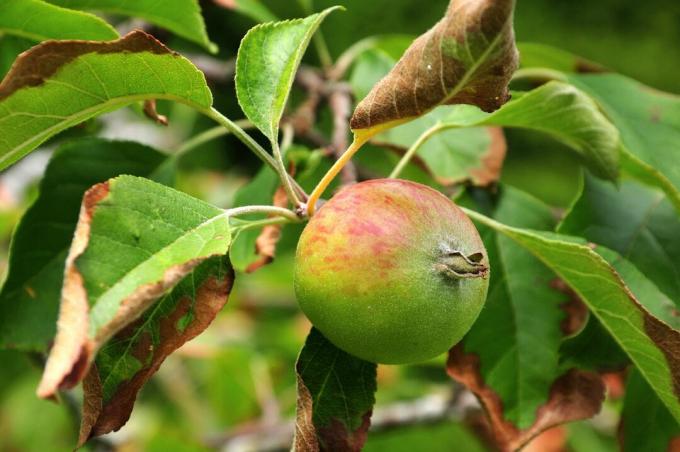The apple variety ‘Reglindis‘ is popular with many gardeners for its excellent health. Tips on growing the apple tree as well as harvesting and using it can be found here.

The early autumn variety ˈReglindisˈ is a so-called “Re variety” from the experienced fruit research institute in Dresden-Pillnitz. The Reglindis apples are small to medium-sized and tasty, and the variety is also suitable their advantageous growth and resistance to all kinds of diseases are particularly good for almost everyone Home garden.
contents
- Apple variety ‘Reglindis‘: profile
- History and origin of the apple variety ‘Reglindis‘
- Reglindis: characteristics and taste
- Reglindis apple: tips on cultivation and care
- Harvest time and use
Apple variety ‘Reglindis‘: Characteristics
| fruit | small to medium in size; yellow base color with light red covering color |
| taste | juicy, mild, sweet and sour |
| Yield | wavering |
| Harvest time | from the beginning of September |
| Ripe for enjoyment | from the beginning of September |
| Shelf life | bad; storable until October |
| growth | medium strength; richly branched |
| climate | no special requirements |
| Diseases and pests | resistant to many diseases |
History and origin of the apple variety ‘Reglindis‘
The Institute for Fruit Research at the Julius Kühn Institute in Dresden-Pillnitz has long been concerned with the goal of finding varieties with strong resistance to the most important ones Apple diseases to breed. Resistance is conveyed via so-called resistance genes, which can be crossed through targeted combination breeding. If a plant has such a resistance, it can hardly be attacked by the associated pathogen. Resistance can be overcome by genetic modification of the pathogen - one then speaks of the "breaking" of resistance. The Re varieties bred in Dresden-Pillnitz have been tested for it for 25 years. The result: Although no pesticides are used, these varieties are still healthy today, so the resistances that have been introduced are still unbroken.
The Reglindisˈ variety is a combination of the ˈ varietiesJames Grieveˈ and ˈBK 44,18ˈ and has been on the market since 1990. Because the breeding of apple varieties is very time-consuming and costly, ˈReglindisˈ has plant variety protection. This means that this variety cannot be propagated and sold free of charge.
Reglindis: characteristics and taste
The small to medium-sized Reglindis apple is medium-high and has a yellow base color that is always only partly, never completely covered by a washed-out light red. The skin is smooth and feels more and more fatty as it ripens, because the cuticle is made up of vegetable fats and waxes. The entire fruit is a bit sensitive to pressure. The flesh inside is fine, rather soft, juicy and has a creamy yellow color. The taste is mild and sweet and sour with a pleasantly fine aroma.

Reglindis apple: tips on cultivation and care
As a variety with high resistance to apple diseases, ˈReglindisˈ is perfect for cultivation by hobby gardeners who want a tree that does not pose a problem.
A medium-good, loamy to sandy garden soil is sufficient for the culture.
The growth is medium strong, the scaffold branches often rise slightly at an angle. The branching is abundant and dense. It can be raised as a slender spindle if the variety is combined with a poorly growing rootstock such as M26, M27, M9 or B9. In this case, however, a permanent connection to a stable pile is essential. The cultivation as a bush tree or high trunk is also successful if stronger roots such as M7, M2 or M4 or even very strong ones such as Bittenfeld seedlings or MM11 are used.

The rootstock of an apple variety not only determines how strong the tree will grow later. The "lower half" of a fruit tree also has an impact on the quality of the fruit, the regularity of the yield and the resistance to soil-borne diseases. In our special article we explain how you yourself Refine apple trees can.
The Reglindisˈ variety is also suitable for difficult locations and high altitudes, because its flowering hardly suffers in cool temperatures. The wood is tolerant of severe frosts and, thanks to the resistance, good yields are achieved even in areas with high pest pressure. Flowering appears mid-early and can fluctuate from year to year, as can the yields. In order not to exacerbate these fluctuations, the ˈReglindisˈ variety should be cut carefully, i.e. never too radically. Suitable pollinators are, for example, Idaredˈ, James Grieveˈ, Pinovaˈ, ˈAlcmeneˈ, ˈCox orangeˈ and ˈOrange Pippinˈ.
ˈReglindisˈ is highly resistant to apple scab and fire blight. Also the fruit tree spider mite and mildew rarely occur.

Harvest time and use
ˈReglindisˈ can be picked from the beginning of September and is then ready to be eaten. The variety cannot be stored very well, all apples should be consumed or preserved by the end of October at the latest. In addition to direct consumption as tasty fruit, Reglindisˈ can be baked well. However, must and cooking is the most popular uses of this variety.
Good dessert fruit varieties, such as the ‘Cox Orange’, are suitable as pollinators for the Reglindis apple. In the examination by pomologists, it achieved the highest scores for its excellent taste. In our portrait you will find everything you need to know about ‘Cox orange‘.

